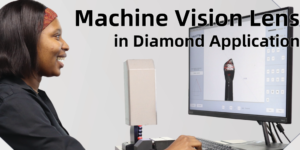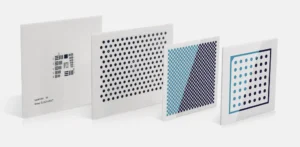In the world of industrial automation and machine vision, accuracy is everything. Whether you’re developing robotic systems, quality control applications, or advanced 3D measurement tools, the precision of your camera system directly impacts your results. This is where OpenCV/Checkerboard Camera Calibration Targets come into play as indispensable tools for achieving reliable, high-precision machine vision.
What are OpenCV/Checkerboard Camera Calibration Targets?
OpenCV/Checkerboard Calibration Targets are specialized tools used in the calibration of 2D industrial and machine vision cameras to detect and correct image distortion or sensor issues, ensuring measurement accuracy for applications requiring precise visual data.
These targets feature a distinct black and white checkered pattern with precisely measured dimensions that help computer vision systems establish the relationship between what the camera sees (2D pixel coordinates) and the actual real-world positions (3D coordinates).
Think of these calibration targets as the “tuning fork” for your machine vision system. Just as musicians use tuning forks to ensure their instruments produce the correct notes, engineers use calibration targets to ensure their cameras capture geometrically accurate images.
Why Camera Calibration Matters
Camera calibration is a critical step in any machine vision application for several important reasons:
- Lens Distortion Correction: All camera lenses, especially wide-angle lenses, introduce some level of distortion. This can appear as barrel distortion (where straight lines bow outward) or pincushion distortion (where straight lines bow inward). Calibration allows your software to mathematically correct these distortions.
- Accurate Measurements: For applications requiring precise measurements from images (such as quality control or dimensional inspection), calibration ensures the pixel-to-real-world measurement conversion is accurate.
- 3D Reconstruction: For stereo vision systems or applications building 3D models from 2D images, proper calibration is essential for accurate depth perception and spatial relationships.
- Improved Algorithm Performance: Many computer vision algorithms perform better when working with undistorted images, making calibration a foundation for reliable algorithm performance.
How OpenCV/Checkerboard Calibration Works
The calibration process using checkerboard patterns follows a well-established method developed by Zhengyou Zhang (often called “Zhang’s method”) and is implemented in OpenCV, the open-source computer vision library used worldwide.
Here’s a simplified breakdown of the process:
- Image Acquisition: Multiple images of the checkerboard target are captured from different angles and orientations.
- Corner Detection: Software (like OpenCV) automatically detects the corners of the checkerboard pattern in each image with sub-pixel accuracy.
- Parameter Estimation: By knowing the physical dimensions of the checkerboard and matching the detected corners across multiple images, the software calculates the camera’s intrinsic parameters (such as focal length and optical center) and distortion coefficients.
- Distortion Correction: These parameters are then used to correct distortion in future images captured by the camera.
Features of High-Quality Calibration Targets
Not all checkerboard targets are created equal. For precise industrial applications, several factors differentiate professional-grade calibration targets:
Material Quality
The substrate material significantly impacts durability and dimensional stability. Options include:
- Quartz Glass: Extremely stable and resistant to temperature changes
- Soda Lime Glass: Affordable with good durability
- Matte Ceramic: Excellent for reducing glare
- Carbon Fiber: Lightweight with high rigidity
- Film and Photographic Paper: More economical options for less demanding applications
Pattern Precision
The accuracy of the checkerboard pattern itself is crucial. Professional targets offer:
- Precise checker widths (ranging from 0.1mm to 15mm)
- Consistent square sizing
- Clear, high-contrast patterns
Feature Accuracy
The manufacturing tolerance of the pattern matters tremendously. High-quality targets maintain accuracies of ±1μm to ±30μm.
Size Options
Targets come in various sizes to accommodate different field of views:
- Small targets (30×30mm to 60×60mm) for close-range inspection
- Medium targets (70×70mm to 150×140mm) for standard machine vision
- Large targets (200×200mm and beyond) for wide-angle or long-range applications
Choosing the Right Calibration Target
When selecting a calibration target for your application, consider these factors:
- Field of View: The calibration target should cover a significant portion of your camera’s field of view for optimal results. For wide-angle lenses, larger targets are necessary.
- Required Accuracy: More demanding applications require higher precision targets with better manufacturing tolerances.
- Environmental Conditions: For calibration in challenging environments (high temperature, moisture, etc.), substrate material selection becomes critical.
- Pattern Configuration: The number of internal corners (typically a grid like 12×9, 12×13, etc.) should be appropriate for your application.
- Edge Distance: The distance from the pattern to the edge of the substrate matters for handling and mounting.
Best Practices for Camera Calibration
To achieve the best calibration results:
- Capture Multiple Images: Take at least 10-15 images of the calibration target from different angles and orientations. This provides more data points for accurate parameter estimation.
- Cover the Field of View: Ensure the calibration target appears in different areas of your camera’s field of view across the image set.
- Maintain Focus: The target should be in sharp focus in all calibration images.
- Provide Varied Orientations: Include images with the target at different angles to the camera plane, not just parallel views.
- Use Consistent Lighting: Even, diffuse lighting prevents glare and shadows that might interfere with corner detection.
- Secure the Target: Ensure the calibration target remains flat and doesn’t flex during the calibration process.
Applications Across Industries
OpenCV/Checkerboard Calibration Targets enable precision in numerous industrial applications:
- Manufacturing Quality Control: Ensuring product dimensions meet exact specifications.
- Robotics: Enabling robots to accurately perceive and interact with objects in their environment.
- Medical Imaging: Calibrating cameras used in minimally invasive surgical equipment.
- Autonomous Vehicles: Calibrating sensors for accurate perception of surroundings.
- Dimensional Measurement: Precise measurement of parts, components, or products.
- 3D Scanning and Reconstruction: Creating accurate 3D models from multiple 2D images.
Our Professional Calibration Target Solutions
Our OpenCV/Checkerboard Calibration Targets are designed to meet the demands of industrial and professional applications where precision matters. We offer:
- Multiple Substrate Options: From economical soda lime glass to premium quartz glass and ceramics.
- Customizable Patterns: Various checker widths (2mm to 15mm) and matrix configurations.
- Size Options: Standard models ranging from 30×30mm to 220×205mm to suit different camera setups.
- Precision Manufacturing: Feature accuracy options from ±1μm to ±2μm for demanding applications.
- Custom Solutions: For specialized requirements, we offer customization with lead times of just 5-7 business days.
Conclusion
Camera calibration is not merely a preliminary step—it’s the foundation upon which reliable machine vision applications are built. High-quality OpenCV/Checkerboard Calibration Targets ensure that this foundation is solid, enabling your systems to perceive the world with exceptional accuracy and reliability.
Whether you’re developing new vision systems, upgrading existing ones, or troubleshooting measurement issues, investing in professional calibration targets yields returns in improved accuracy, reduced errors, and enhanced system performance. In the precision-driven world of industrial machine vision, proper calibration isn’t just good practice—it’s essential.
Ready to enhance the accuracy of your machine vision systems? Explore our range of professional calibration targets or contact our team to discuss custom solutions tailored to your specific requirements.










